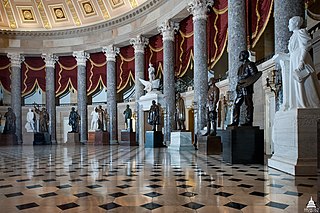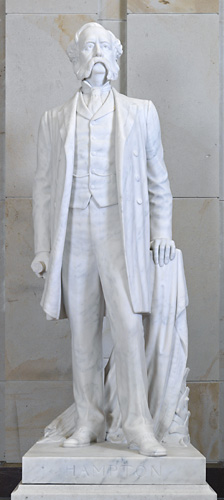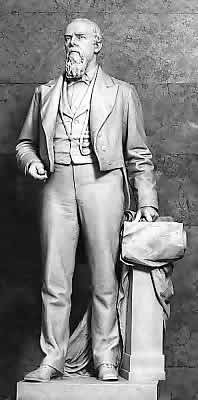
Felix Weihs de Weldon was an American sculptor. His most famous pieces include the United States Marine Corps War Memorial in the Arlington National Cemetery, Virginia, US, and the Malaysian National Monument (1966) in Kuala Lumpur.

The National Statuary Hall is a chamber in the United States Capitol devoted to sculptures of prominent Americans. The hall, also known as the Old Hall of the House, is a large, two-story, semicircular room with a second story gallery along the curved perimeter. It is located immediately south of the Rotunda. The meeting place of the U.S. House of Representatives for nearly 50 years (1807–1857), after a few years of disuse it was repurposed as a statuary hall in 1864; this is when the National Statuary Hall Collection was established. By 1933, the collection had outgrown this single room, and a number of statues are placed elsewhere within the Capitol.

The National Statuary Hall Collection in the United States Capitol is composed of statues donated by individual states to honor persons notable in their history. Limited to two statues per state, the collection was originally set up in the old Hall of the House of Representatives, which was then renamed National Statuary Hall. The expanding collection has since been spread throughout the Capitol and its Visitor's Center.

Jo Davidson was an American sculptor. Although he specialized in realistic, intense portrait busts, Davidson did not require his subjects to formally pose for him; rather, he observed and spoke with them. He worked primarily with clay, while the final products were typically cast in terra-cotta or bronze, or carved from marble.

Charles Henry Niehaus was an American sculptor.

The United States Capitol rotunda is the tall central rotunda of the United States Capitol in Washington, D.C. It has been described as the Capitol's "symbolic and physical heart". Built between 1818 and 1824, the rotunda is located below the Capitol dome, which was built between 1857 and 1866.

Franklin Bachelder Simmons was a prominent American sculptor of the nineteenth century. Three of his statues are in the National Statuary Hall Collection, three of his busts are in the United States Senate Vice Presidential Bust Collection, and his statue of Ulysses S. Grant is in the United States Capitol Rotunda.

Belle Marshall KinneyScholz (1890–1959) was an American sculptor, born in Tennessee who worked and died in New York state.
Leopold Scholz (1877–1946) Austrian born American sculptor best known for his works in the National Statuary Hall Collection housed in the US Capitol in Washington D.C.

Will Rogers is a statue created by Jo Davidson, two versions of which were unveiled in 1938.

Brigham Young is a marble statue by Mahonri Young representing the Mormon religious leader of the same name, installed in the United States Capitol, in Washington D.C., as part of the National Statuary Hall Collection. It is one of two statues donated by the state of Utah, and is unusual in the collection in that Young is portrayed sitting down. The statue was unveiled by Alben William Barkley on June 1, 1950.

Henry Clay is a 1929 bronze sculpture by Charles Henry Niehaus depicting the lawyer and politician Henry Clay, installed in the United States Capitol in Washington D.C. as part of the National Statuary Hall Collection. It is one of two statues donated by the state of Kentucky. The statue was accepted into the collection by Virgil Chapman on March 3, 1929.

Wade Hampton III is a 1929 marble sculpture depicting the military officer and politician of the same name by Frederick Ruckstull, installed in the United States Capitol, in Washington D.C., as part of the National Statuary Hall Collection. It is one of two statues donated by the state of South Carolina. The statue was accepted in the collection by Duncan Heyward on June 10, 1929.

John M. Clayton is a 1934 marble sculpture depicting the American lawyer and politician of the same name by Bryant Baker, installed in the United States Capitol, in Washington D.C., as part of the National Statuary Hall Collection. It is one of two statues donated by the state of Delaware The statue was accepted in the collection by Robert G. Houston on June 6, 1934.
Huey Long is a 1941 bronze sculpture of Huey Long by Charles Keck, installed in the United States Capitol, in Washington, D.C., as part of the National Statuary Hall Collection. It is one of two statues donated by the state of Louisiana.

Andrew Jackson is a 1928 bronze sculpture of Andrew Jackson by Belle Kinney Scholz and Leopold Scholz, installed in the United States Capitol, in Washington D.C., as part of the National Statuary Hall Collection. It is one of two statues donated by the state of Tennessee. The statue was accepted into the collection by Senator Kenneth McKellar on April 16, 1928.

John James Ingalls is a 1905 marble sculpture of the politician of the same name by Charles Henry Niehaus, installed in the United States Capitol, in Washington, D.C., as part of the National Statuary Hall Collection. It was one of two statues donated by the state of Kansas. The statue was accepted in the collection by Senator Arthur P. Gorman on January 21, 1905. On July 27, 2022, it was replaced by a Statue of Amelia Earhart.

Oliver P. Morton is a 1900 marble statue of Governor Oliver P. Morton by Charles Henry Niehaus installed in the United States Capitol, in Washington, D.C., as part of the National Statuary Hall Collection. It is one of two statues donated by the state of Indiana. The statue was accepted into the collection on April 14, 1900, by Indiana Senator Albert J. Beveridge.,

John Campbell Greenway is a 1930 bronze statue of John Campbell Greenway by Gutzon Borglum, one version of which was installed in the United States Capitol, in Washington D.C., as part of the National Statuary Hall Collection. It was one of two statues donated by the state of Arizona. The sculpture was unveiled by Senator Henry Ashurst of Arizona on May 24, 1930.

There are several works of art in the United States Capitol honoring former leaders of the Confederate States of America and generals in the Confederate States Army, including seven statues in the National Statuary Hall Collection, busts and portraits.
















